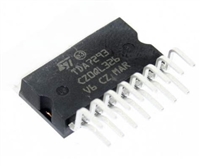ADSP-BF531/ADSP-BF532
population count, modulo 232 multiply, divide primitives, satu-
ration and rounding, and sign/exponent detection. The set of
video instructions includes byte alignment and packing opera-
tions, 16-bit and 8-bit adds with clipping, 8-bit average
operations, and 8-bit subtract/absolute value/accumulate (SAA)
operations. Also provided are the compare/select and vector
search instructions.
The Blackfin processor assembly language uses an algebraic syn-
tax for ease of coding and readability. The architecture has been
optimized for use in conjunction with the C/C++ compiler,
resulting in fast and efficient software implementations.
MEMORY ARCHITECTURE
The ADSP-BF531/ADSP-BF532 processor views memory as a
single unified 4G byte address space, using 32-bit addresses. All
resources, including internal memory, external memory, and
I/O control registers, occupy separate sections of this common
address space. The memory portions of this address space are
arranged in a hierarchical structure to provide a good cost/per-
formance balance of some very fast, low latency on-chip
memory as cache or SRAM, and larger, lower cost and perfor-
mance off-chip memory systems. See Figure 3 on Page 7, and
Figure 4 on Page 7.
For certain instructions, two 16-bit ALU operations can be per-
formed simultaneously on register pairs (a 16-bit high half and
16-bit low half of a compute register). By also using the second
ALU, quad 16-bit operations are possible.
The 40-bit shifter can perform shifts and rotates and is used to
support normalization, field extract, and field deposit
instructions.
The program sequencer controls the flow of instruction execu-
tion, including instruction alignment and decoding. For
program flow control, the sequencer supports PC relative and
indirect conditional jumps (with static branch prediction), and
subroutine calls. Hardware is provided to support zero-over-
head looping. The architecture is fully interlocked, meaning that
the programmer need not manage the pipeline when executing
instructions with data dependencies.
The L1 memory system is the primary highest performance
memory available to the Blackfin processor. The off-chip mem-
ory system, accessed through the external bus interface unit
(EBIU), provides expansion with SDRAM, flash memory, and
SRAM, optionally accessing up to 132M bytes of
physical memory.
The memory DMA controller provides high bandwidth data-
movement capability. It can perform block transfers of code or
data between the internal memory and the external
memory spaces.
The address arithmetic unit provides two addresses for simulta-
neous dual fetches from memory. It contains a multiported
register file consisting of four sets of 32-bit index, modify,
length, and base registers (for circular buffering), and eight
additional 32-bit pointer registers (for C-style indexed stack
manipulation).
Internal (On-Chip) Memory
The ADSP-BF531/ADSP-BF532 processor has three blocks of
on-chip memory providing high bandwidth access to the core.
Blackfin processors support a modified Harvard architecture in
combination with a hierarchical memory structure. Level 1 (L1)
memories are those that typically operate at the full processor
speed with little or no latency. At the L1 level, the instruction
memory holds instructions only. The two data memories hold
data, and a dedicated scratchpad data memory stores stack and
local variable information.
The first is the L1 instruction memory, consisting of up to
48K bytes SRAM, of which 16K bytes can be configured as a
four way set-associative cache. This memory is accessed at full
processor speed.
The second on-chip memory block is the L1 data memory, con-
sisting of one bank of 32K bytes. The memory bank is
configurable, offering both cache and SRAM functionality. This
memory block is accessed at full processor speed.
In addition, multiple L1 memory blocks are provided, offering a
configurable mix of SRAM and cache. The memory manage-
ment unit (MMU) provides memory protection for individual
tasks that may be operating on the core and can protect system
registers from unintended access.
The third memory block is a 4K byte scratchpad SRAM which
runs at the same speed as the L1 memories, but is only accessible
as data SRAM and cannot be configured as cache memory.
The architecture provides three modes of operation: user mode,
supervisor mode, and emulation mode. User mode has
restricted access to certain system resources, thus providing a
protected software environment, while supervisor mode has
unrestricted access to the system and core resources.
External (Off-Chip) Memory
The external bus interface can be used with both asynchronous
devices such as SRAM, FLASH, EEPROM, ROM, and I/O
devices, and synchronous devices such as SDRAMs. The bus
width is always 16 bits. A1 is the least significant address of a
16-bit word. 8-bit peripherals should be addressed as if they
were 16-bit devices, where only the lower eight bits of data
should be used.
The Blackfin processor instruction set has been optimized so
that 16-bit opcodes represent the most frequently used instruc-
tions, resulting in excellent compiled code density. Complex
DSP instructions are encoded into 32-bit opcodes, representing
fully featured multifunction instructions. Blackfin processors
support a limited multi-issue capability, where a 32-bit instruc-
tion can be issued in parallel with two 16-bit instructions,
allowing the programmer to use many of the core resources in a
single instruction cycle.
The PC133-compliant SDRAM controller can be programmed
to interface to up to 128M bytes of SDRAM. The SDRAM con-
troller allows one row to be open for each internal SDRAM
bank, for up to four internal SDRAM banks, improving overall
system performance.
Rev. D
|
Page 5 of 60
|
August 2006






 ?TPA3116D2功放芯片参数详解、引脚说明
?TPA3116D2功放芯片参数详解、引脚说明

 74HC165引脚说明、驱动程序示例解读
74HC165引脚说明、驱动程序示例解读

 深入解析AD9833:DDS频率合成器的卓越性能与广泛应用
深入解析AD9833:DDS频率合成器的卓越性能与广泛应用

 高性能TDA7293音频功率放大器技术特性与应用分析
高性能TDA7293音频功率放大器技术特性与应用分析
